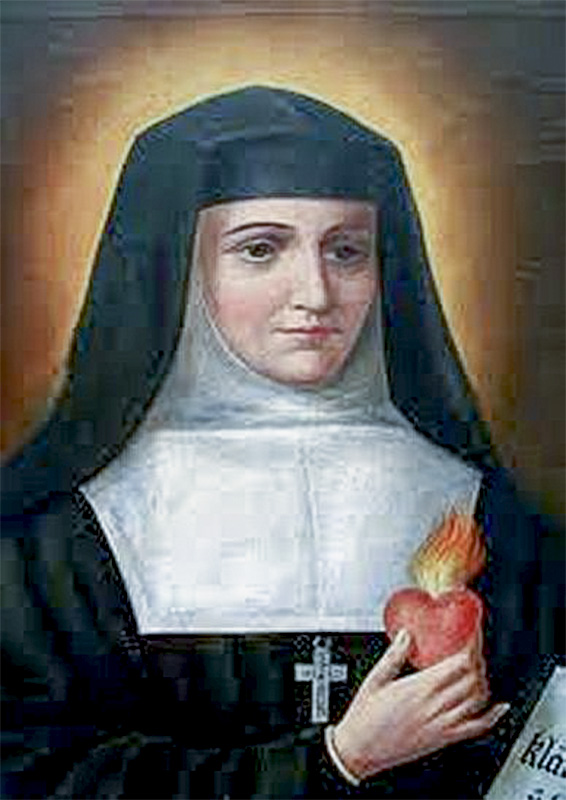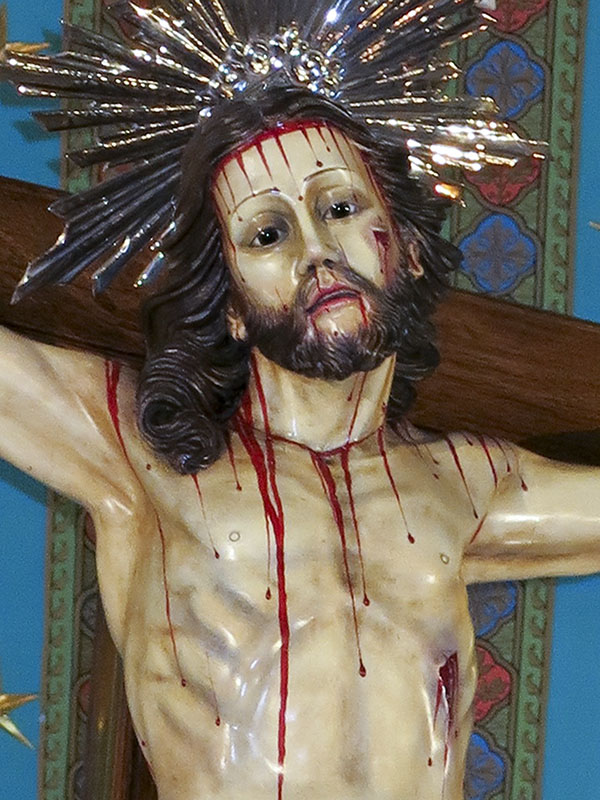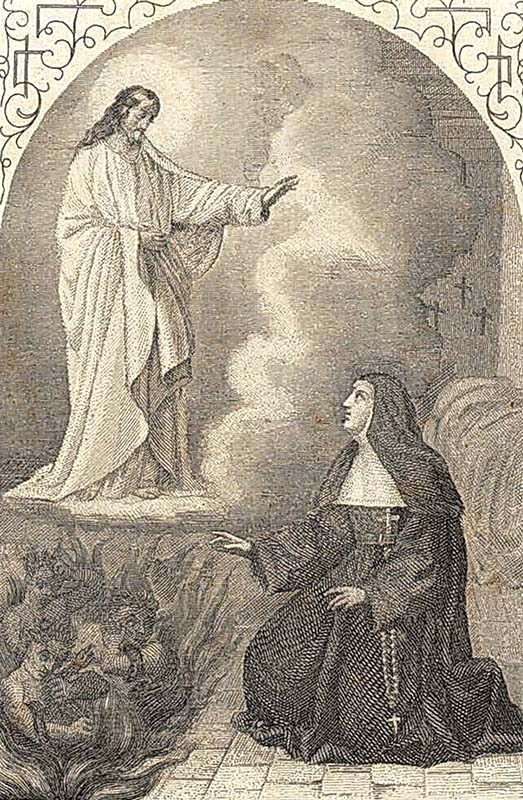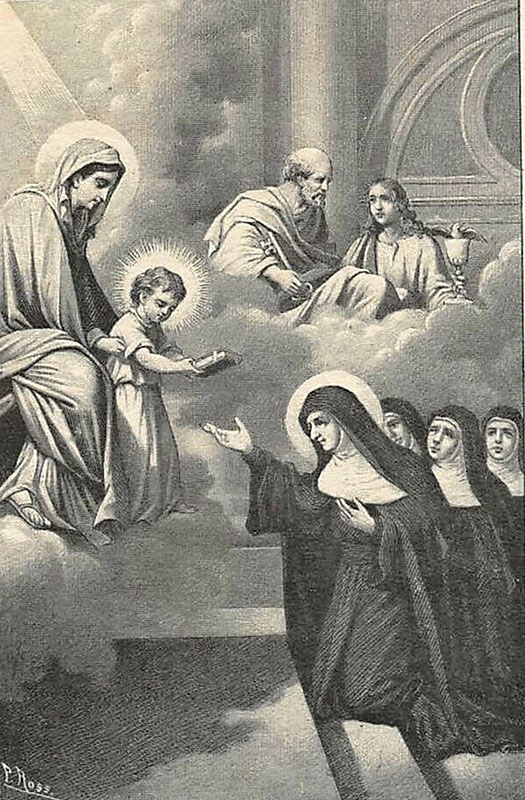
Animated by the same zeal that led St. Ignatius of Loyola to constitute his work, Joan of Lestonnac founded the Company of Mary, in which Our Lady would be the Captain of a militia of virgins dedicated to the salvation of souls.
It was December 27, 1556. In the city of Bordeaux, France, chimneys were still exhaling the aroma of Christmas breads and cookies. The pealing of the Cathedral bells invited the faithful to the celebration for the feast of St. John the Evangelist, Beloved Disciple and guardian of the Blessed Virgin. In a luxurious mansion, Richard of Lestonnac, a councillor of the Parliament, cradled in his arms little Joan, his new-born first child.
He thought of his wife, also named Joan, sister of the famous humanist Michel de la Montaigne, who, ensnared by Calvinist ideas, had abandoned the Faith and opposed the Baptism of her little daughter. A fervent Catholic, Richard prayed at that moment to St. John the Evangelist, entrusting the tiny child to him. The great Saint would hear the prayers of that truly paternal heart: the little girl would be baptized and would have such a special bond with her patron that she would call him “my brother”!
“We have escaped as a bird…”
With Baptism, an unusual path of heroic faith begins for Joan, marked by steadfastness and perseverance in the fight against evil. As a child, she learns to read and write, and she masters Greek and Latin, but is constantly subjected to insults, punishments and ill-treatment from some relatives who at all costs try to persuade her to embrace Calvinism. Her innocence leads her to energetically reject the onslaughts of her cousins, an aunt and, above all, her own mother.
As time goes by, the girl finds solid support in one of her brothers, who, a student at a renowned Catholic school, transmits to her the teachings he acquires in the classroom, which demonstrate and refute the deviations of the heresy in vogue.
Cherishing, in spite of everything, special affection for her mother, one day the girl decides to openly declare to her the fears that troubled her child’s heart about the eternal salvation of the Calvinists. The response to this gesture of filial love are bitter words, which deeply shock Joan, followed by such distant and cold treatment that from then on, the child lives as though she has no mother.
However, Divine Providence will shower Joan with abundant graces and mystical communications from the Blessed Virgin, her Guardian Angel and St. John the Evangelist. In this way, she will experience, like her patron Saint, Mary’s predilection, and will feel caressed in her virginal arms, as if God Himself were saying to her: “Daughter, behold your Mother!” Unfortunately, only in Heaven will we be able to know all the favours that St. Joan received, for before her death she burned her spiritual diary…
Decades later, Joan would recall these clashes from the first years of life with joy and gratitude, and was wont to repeat the following words of the psalmist, applying them to herself: “We have escaped as a bird from the snare of the fowlers; the snare is broken, and we have escaped!” (Ps 124:7). Yes, the Mother of God did not allow this beloved daughter to succumb at any time to the deceptions of heresy!
An invitation to approach the Cross
Joan was seventeen years old when, while at prayer, she was enraptured by the Holy Spirit and made an offering of her life, presenting to God her desire to become a religious. At the same time, however, she was at His disposal to do His will.
The doctrinal deviations that were rampant in France had entered into many monasteries, which is why her father, concerned about the risks to which his daughter would be exposed if she entered the cloister, asked her to renounce this way. Joan interpreted her father’s request as the desire of Providence and an invitation to follow the Divine Crucified One more closely. One day, while in prayer, she heard Our Lord say to her: “Take care, my child, to not permit the quenching of this fire, which I have placed in your heart and which impels you to My service with such fervour.”1
Shortly thereafter, Joan married Gaston de Montferrand, a noble military man and a partisan of good religious principles and virtue. Seven children were born of this union, three of whom died when they were still small, a cause of great sorrow for their loving mother. Her main concern in the education of her offspring was to form ardent devotees of Our Lady, the name of Mary being the first word that she taught them to pronounce. Two of her daughters, Martha and Magdalene, would later follow a religious vocation.

“Take care, my child, to not permit the quenching of this fire which I have placed in your heart”
Widowed, she leaves her own and becomes a Cistercian
After twenty-four years of marriage, her husband having died, Joan decided to leave the world to enclose herself within the Cistercian Monastery of Our Lady of Feuillant, where she would adopt the name of Joan of St. Bernard. Before that, however, she had to fight against the opposition of her eldest son, already married, who tried to dissuade her from making this decision.
Although already in her forties, Joan had maintained her youthfulness and the disposition of a fifteen-year-old. In the monastery, there was no labour she did not undertake or sacrifice she did not embrace. Above all, she was fervent and assiduous in prayer, dedicating many hours to it.
However, when winter came, a terrible illness struck her and the doctors soon pronounced the harsh sentence: if she did not want to die, she would have to return to the world, because the dietary regimen required by the rule and the lack of resources for medicine would make her recovery impossible.
The Company of Mary is born
It was Christmas Eve when the Mother Superior found herself obliged to send Joan away from the monastery. However, she allowed her to spend her last night there in prayer vigil. These hours were an “agony in the Garden,” during which Joan felt alone, lost, full of perplexities and a troubled mind.
What were God’s plans for her? She had not been able to follow Him in her youth and now that she had embraced her religious vocation she was forced to abandon it! In the midst of that terrible Calvary, she prayed: “My God, set my thoughts and my steps on the path that pleases Thee, without taking into account my desires or my loathing; I want what Thou desirest: consolation or suffering, life or death, for me everything is the same, as long as I love Thee, serve Thee and glorify Thee; and that I be Thine and Thou be mine.”2
She then had an extraordinary vision: she contemplated a multitude of souls about to fall into hell, reaching out to her in a plea for help, while Our Lord Jesus Christ indicated that it was up to Joan to prevent their perdition. She then saw Our Lady in her unequalled purity and perfection, and understood that she had to begin a new foundation in her service.
Ignited with the same spirit that led the great St. Ignatius of Loyola to constitute the Company of Jesus, Joan of Lestonnac was to organize the Company of Mary, in which the Blessed Virgin would be “Queen, Model and Captain of an militia of virgins who, under her name and standard, consecrated to her honour and imitation, would dedicate their lives to the salvation of souls and the greater glory of God.”3
If confronting heretical men was no easy task, fighting doctrinal deviations among women would require steadfastness and sagacity from St. Joan, given that, to move them, mere reasoning based on principles is not always sufficient. It would be necessary, before all else, to point out to them the great ideal to which they would devote themselves with love and generosity.
Divine inspirations are confirmed
Leaving the Cistercian milieu, Joan returned to her family environment in Bordeaux and, after some time, revealed the plan of the foundation to two priests. However, they were not willing to give her the necessary support.
As a serious epidemic was spreading throughout France, Joan and other nobles went into action to help the sick. Only later would she realize that in this way Providence was laying the first roots of the desired foundation!
At this time, a renowned Jesuit priest, Fr. Jean de Bordes, was on mission in the Bordeaux region, together with another priest named François de Raymond. They lamented to see so many, especially young people, dying without the Sacraments and ensnared by heresy for lack of education.

Fighting doctrinal deviations among women would require steadfastness and sagacity from St. Joan
One day, while the two ministers celebrated Mass individually, they received a supernatural communication through an interior voice: they heard that the creation of a women’s religious institute similar to the Society of Jesus was necessary…
At the end of the Holy Sacrifice, the priests met and confided the extraordinary grace to one another, noting, surprised, that it was the same message and that both had received it at the same time. There was no doubt that the announcement was from God; but who would be the lady capable of carrying out such an undertaking?
After reflecting together and praying for insights from the Most High, they decided to present the proposal to two ladies of the city, who seemed to meet the requirements. The first adamantly rejected the idea, and so they exposed the plan to the second, who was none other than Joan of Lestonnac. She accepted the proposal with serene enthusiasm, telling them of her earlier vision in the Cistercian convent. All the inspirations were thus confirmed!
Obstacles to the foundation
At first, the project of the foundation was welcomed by Cardinal François d’Escoubleau de Sourdis, Archbishop of Bordeaux, who received the texts of the constitutions directly from the hands of St. Joan, submitted for his approval.

However, when she and her followers returned to the palace a few days later, the prelate proved cold and hostile. He declared that he would not approve the institute, since the Ursuline Sisters, who needed collaborators, were already present in the city; therefore, Joan and her disciples should enter this already existing Order. Upon hearing this decision, the holy foundress energetically replied: “Your Eminence, I respect your opinions, but I cannot betray my vocation. I immensely esteem the Congregation of which you speak, but I have not been called to it. I must follow the voice of Heaven, which has always inspired me to found another Company, with other rules and under another name.”4
The Cardinal remained reluctant for several more days. Finally, on Marcy 25, 1606, he sent the act of the approval of the institute to Rome, soliciting its confirmation. On May 1, 1608, he himself presided over the first imposition of habits on the new religious.
Amidst persecution
Having overcome this first obstacle, it was not long before the scheming winds of slander blew over the new-born work. St. Joan, like the rock battered by the waves of the rough sea, remained immovable and undaunted. She was not concerned with malicious tongues; her goal was that souls be instructed in the truth and saved.
If, on the one hand, her apostolate grew more and more, on the other hand, so did the criticism. Her projects were deemed excessively grand and high-flown; as a result, when she needed to set up new houses to continue the work, she found no financial support. With mastery and, above all, a great deal of faith, she gradually managed to touch hardened hearts, turning some of her enemies into her greatest benefactors.
After two years of novitiate, the time had come for the religious to profess their vows. However, to everyone’s surprise, the Cardinal once again set himself in opposition, demanding that they merge with the Ursulines… Steadfast in her decisions, Mother Joan declared to the Prelate that, as this involved the glory of Mary Most Holy, she would never give in.
“Your Eminence, I respect your opinions, but I cannot betray my vocation. I must follow the voice of Heaven”
It was the Mother of God herself who intervened to overcome this obstacle. The Cardinal was on his way to Rome when Our Lady appeared to him, explaining her desires with respect to the foundation and obliging him to fulfil them. Thus, on the feast of the Immaculate Conception in 1610, the first solemn profession of vows would take place. It was a happy day, purchased at the cost of the blood shed by the Foundress in a spiritual Calvary, perhaps unknown to her daughters!
Three years of sorrowful martyrdom
From the beginning, St. Joan encouraged the growth of the work, desiring to go beyond the borders of France and conquer new lands. Thus, as her apostolate developed, the first religious left Bordeaux to found houses in other places. Among those who remained in the city was Blanche Hervé, a fickle woman of remarkable pride. Taken by envy and ambition, with the support of a bad cleric, she invented grave calumnies to once again turn the Cardinal against the foundress, accusing her of encouraging her followers not to obey the prelate.
This same individual fomented a revolution within the monastery, to which other sisters joined, causing a division. The rebels removed St. Joan from her office as Superior General, forbidding her to have contact with her spiritual daughters and prohibiting any correspondence.
Taken by envy and ambition, one of the nuns invented grave calumnies, with the support of a bad cleric
Blanche Hervé even threatened to obtain an order from Rome to take away the veil from the foundress and send her away to care for the swine at her old farmhouse. St. Joan lived a daily martyrdom of three years, suffering constant insults, humiliations and even physical abuse. Amidst the sorrow and abandonment, she never uttered a word of complaint. She knew that to take up the cross did not only mean to carry it, but also to allow herself to be nailed to it.
Finally, overcome by the meekness, sweetness and holy examples of her foundress, the rebel recognized her error and asked forgiveness. St. Joan, however, preferred not to reassume the position of superior, dedicating her last years to writing the rules.
“Let us wash our souls in the Blood of the Lamb”
On January 30, St. Joan suffered a cerebral haemorrhage and died on February 2, 1640. Her body, entirely supple and intact, seemed to radiate light. The wrinkles had disappeared from her face, her eyes remained open and seemed to reflect life. At the exhumation of her body years later, they found it just as it had been on the day of her burial.5
The example of this admirable lady charts a path of light and heroism, whose secret can be summed up in the words she used to repeat to her spiritual daughters: “Let us love, let us love Jesus covered with wounds for love of us. Let us wash our souls in the Blood of the Lamb. Whoever does not love Jesus, suffering and put to death by men, let them be anathema! For love, for crucified love! Let us be close to the Blessed Virgin, our glorious Mother, and to St. John. Together with them, let us love this God whose love, the cause of ours, is infinite in its nature, eternal in its duration and prodigious in its gifts.”6 ◊







